Imagine a kitchen filled with the comforting aroma of freshly baked gluten free sourdough bread, the crisp golden crust yielding to the soft crumb within. If you have wanted to learn how to bake sourdough sandwich bread, this is an incredible, easy recipe!
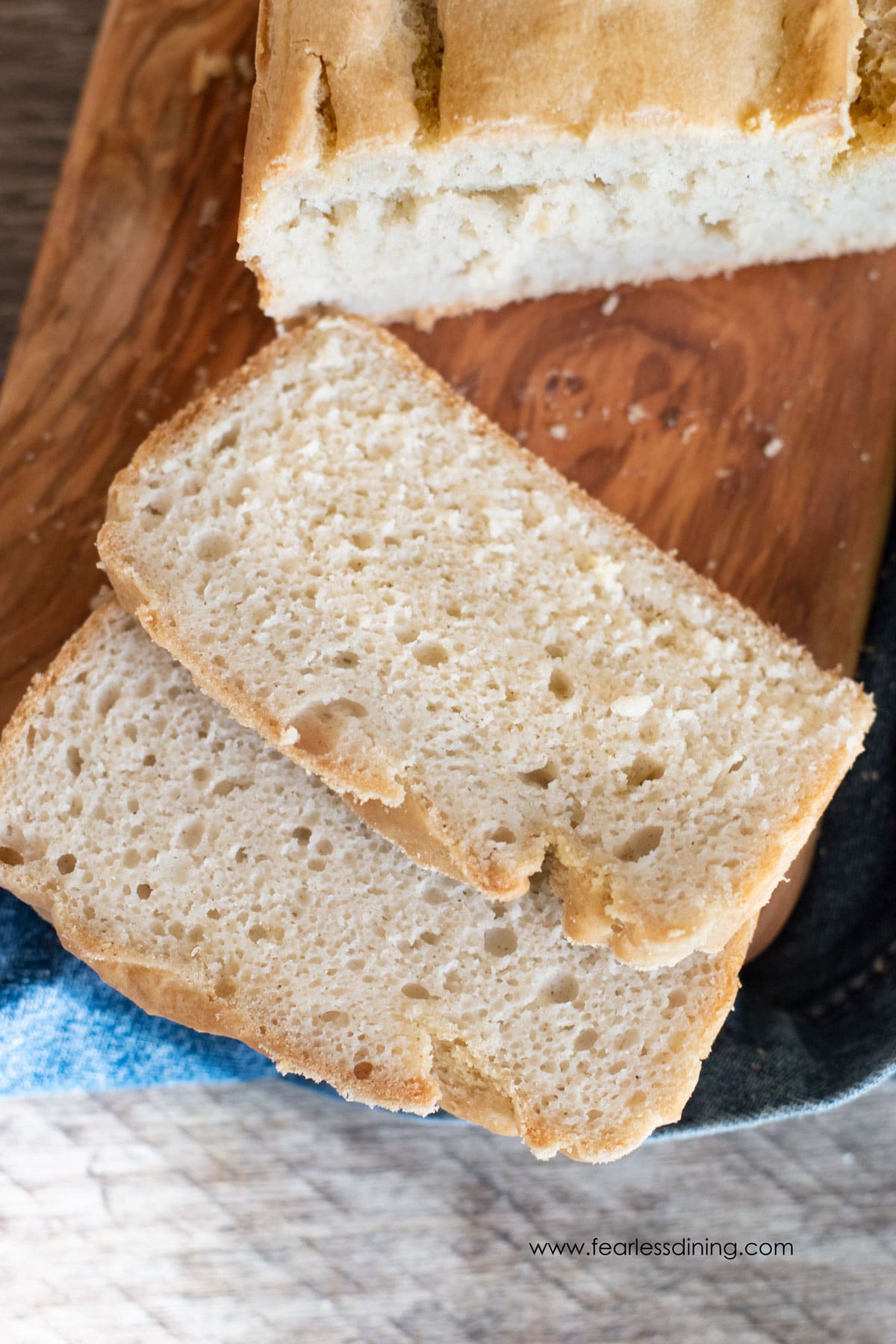
🔑 Sandi says: This post was updated and reorganized from an older 2014 post. I included a lot more tips from myself and readers to help you make this recipe with success. This is a recipe that I recommend you read the entire post.
There is nothing better than the taste of fresh sourdough bread! It is seriously (or should I say Srsly) the most incredible comfort food! This original recipe comes from Sadie, founder of the famous Bread Srsly in San Francisco. Please know this recipe is not her current recipe, as she has tweaked it over the years, but it turns out incredibly! (I have also streamlined this recipe since she first shared her recipe with me back in 2014.)
Sadie used a combination of millet, sorghum, brown, and white rice flour in her original recipe. Many of us don’t have a lot of individual flours on hand…so it was important for me to simplify the ingredients. This is an excellent introduction if you want to try making a version of Bread Srsly’s famous sourdough bread.
Recipe At A Glance:
Allergen Information:
This sourdough bread is also egg-free, dairy-free, nut-free, soy-free, and completely vegan, so it is perfect for those with food allergies!
If you love baking gluten free bread as much as we do, check out my delicious gluten free bread recipes.
Do This First:
Go to my How to Make a Gluten Free Sourdough Starter page and make your gluten free starter! Do this first because there is no sourdough bread without an active starter!! For a list of tools you need, please read my article on Sourdough Tools.
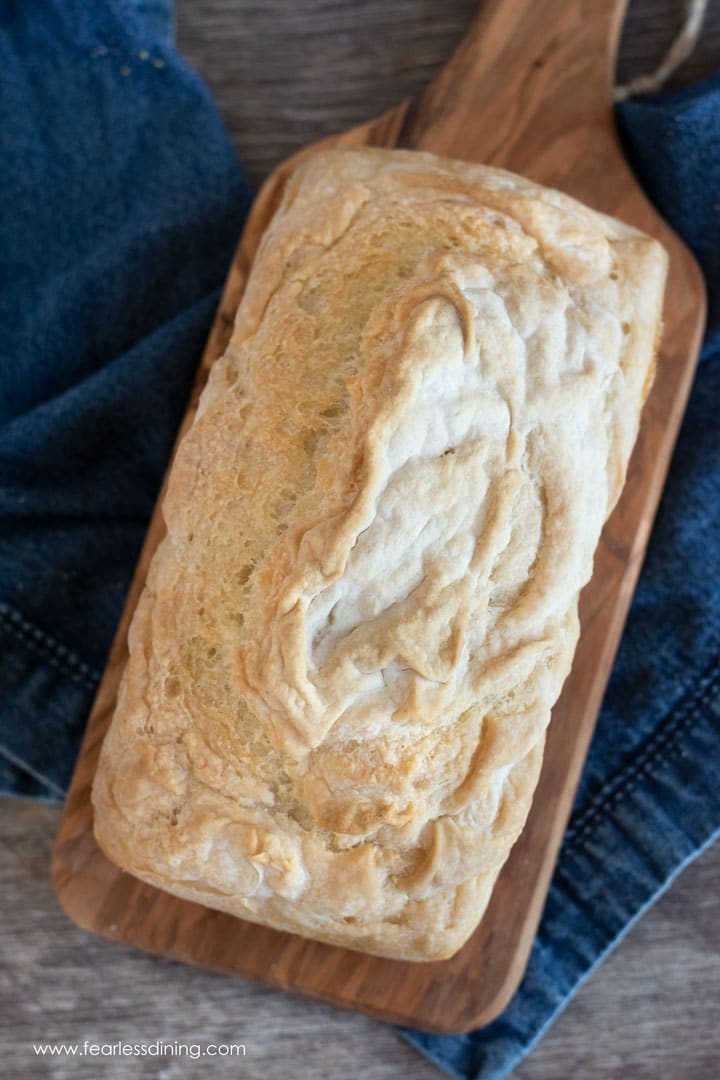
A Note on Gluten Free Flour Blends:
I have tested several different gluten free blends. I talk a lot about King Arthur Measure for Measure, which is a standard blend. I also used a very starch-heavy gluten free flour blend by GF Jules. Both performed very well.
The main difference is the texture of the bread on the inside. Both had a nice crusty outside. GF Jules was much lighter and fluffier on the inside, while the King Arthur flour blend loaf was a little more hearty, like regular sourdough bread.
Many of my readers have chimed in with different flour blends they have tried in the comments, so I encourage you to keep reading through everyone’s comments. Dana loved Bob’s Red Mill 1 to 1 Gluten Free Blend with this recipe.
Reader Rave
I made mine with Krusteaz Gluten Free 1 to 1 flour, and it turned out great. I will definitely be making it again. Thanks for the tips on buttering the top and baking with water/steam. The crust is perfect.” Veronica R.
Step-By-Step Photos and Directions:
We are finally ready to make this gluten-free sourdough bread loaf! Are you as excited as I am?
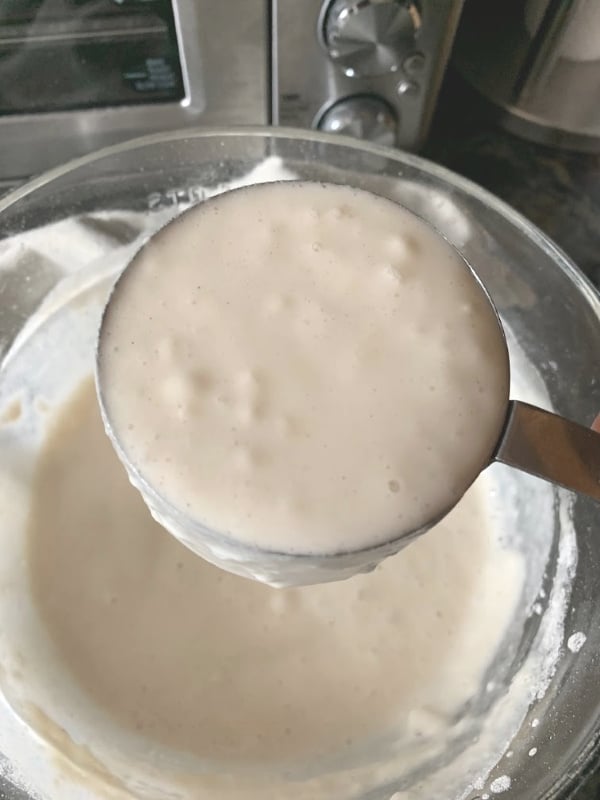
Step 1: You will need ¾ cup of gluten free starter. Make sure it is bubbling and at room temperature! If you refrigerate your starter, take it out of the refrigerator the night before you plan to make bread. I take a discard, feed it with gluten-free flour and water, and let it sit on the counter overnight.
You will want your starter warmer if it is a cold season, especially winter. I like to put my starter either in the oven with the light on or on my Euro Cuisine Yogurt Maker base (with two folded dish towels on it so the starter doesn’t get too hot.)
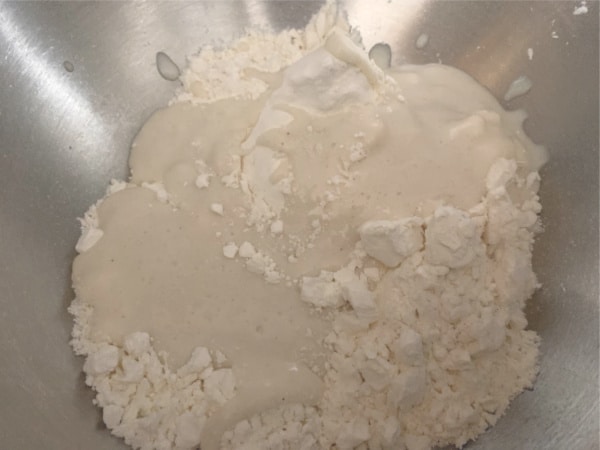
Step 2: Put the gluten-free flour and salt into a large
Why Water Quality Is Important:
I always use purified water when making sourdough or baking with yeast. Chlorine and chemicals in our tap water can kill your yeast and inhibit the rise. If you want the best rise, you must use purified water that doesn’t contain these chemicals.
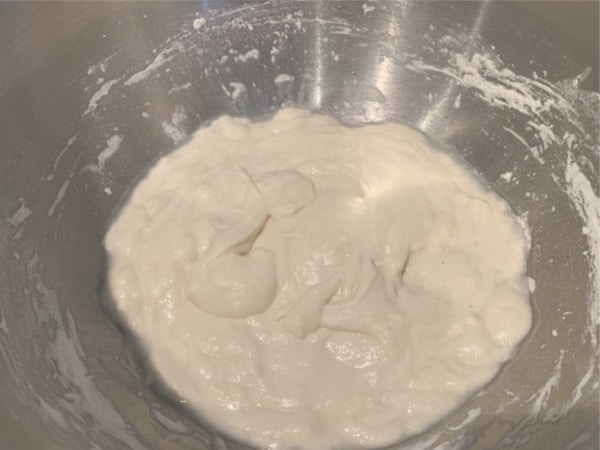
Step 3: Mix the wet and dry ingredients well. You want a wet dough, like a thick pancake batter.
Step 4: Cover loosely with plastic wrap and let the dough rise for 3 hours (go by how big it rises). I then gently move the dough to a greased bread loaf pan and let it sit for another 3-4 hours. If you are not using a metal pan, you can do the whole rise in the bread pan!! Cover with a damp towel so the dough doesn’t dry out.
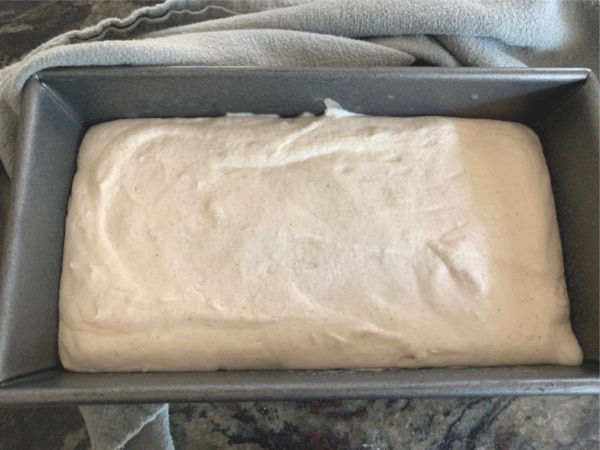
This is my favorite option so far – let it rise in the pan you’ll use for baking and it has the softest crust and best crumb of the four 5 recipes I’ve tried, while still being super easy.”
Sara K.
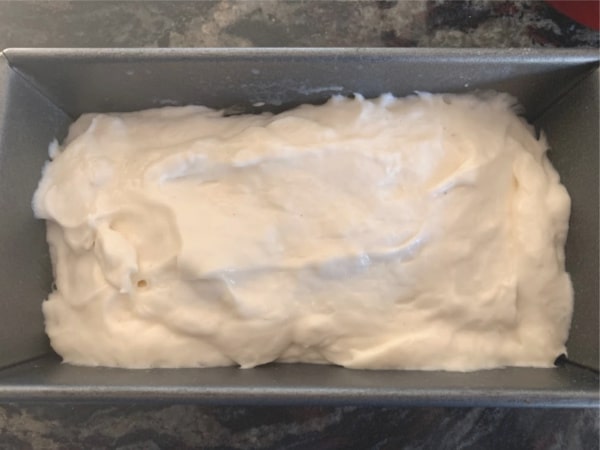
Note that the King Arthur Measure for Measure was a little runnier in consistency. The GF Jules has a much higher starch content and looks much fluffier!
Step 5: Bake the gluten free sourdough loaf for 45 minutes at 425º F. I noticed it hadn’t browned on top – so I brushed the top with melted butter at the 45-minute mark and then quickly closed the oven door.
Hurry when gently brushing the melted butter on- the longer the oven is open, and the rack pulled out a bit – will lose a tiny bit of its rise. Once the oven is closed again, the rise comes back quickly.
Step 6: Bake for another 30 minutes and test the bread with a probe-style thermometer showing 200-210º F in the center. Note: the bake time will vary depending on the size and depth of the pan you bake your bread in.
If you notice that the thermometer has a bit of residue on the probe, you can turn off the oven and leave the loaf in the oven to cool so it finishes baking and cooling more gently to keep as much of the final baked-in rising and fluff.
Step 7: Carefully move the bread to a cooling rack. Cool the bread completely before removing it from the pan and slicing it with a serrated bread knife. You want the bread to cool for a minimum of 3-4 hours before slicing it.
Read my Gluten Free Bread Troubleshooting Guide for more tips and possible troubleshooting.
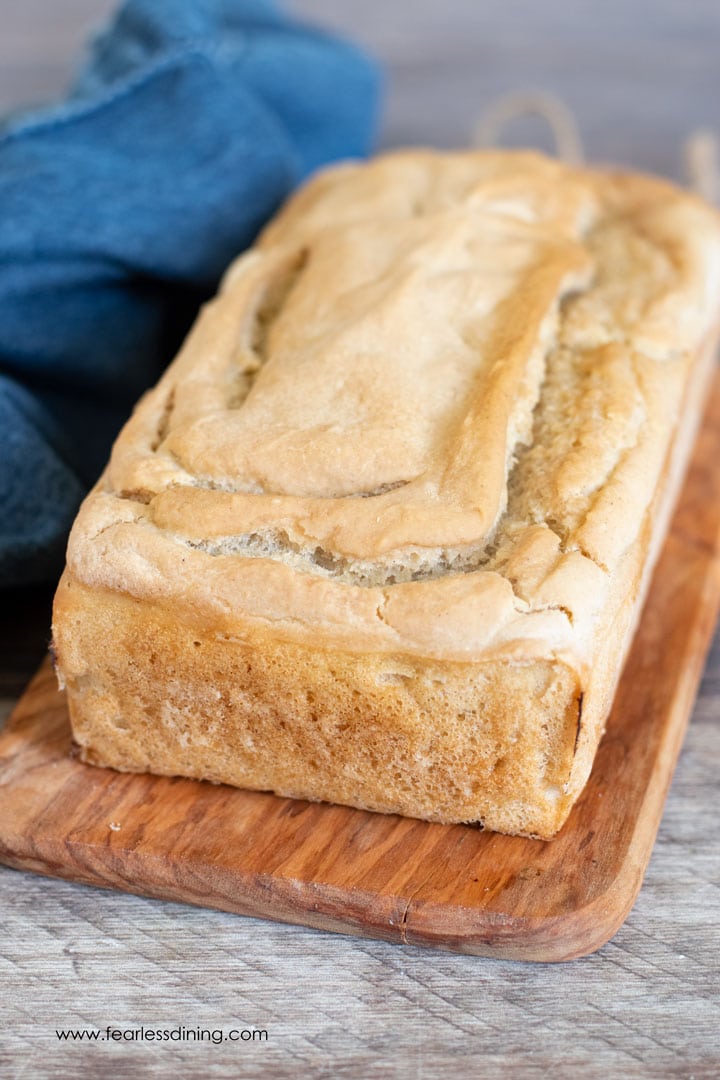
How to get crusty bread:
If you love crusty bread, try this artisan Gluten Free Sourdough Boule recipe! I also love this Gluten Free Cranberry Walnut Sourdough Bread.
I highly recommend baking this bread with a pan of hot water to create steam. Sadie at Bread Srsly didn’t do this, but I found baking with hot steam creates a really good crust to the bread.
To get steam, you can fill a shallow baking dish with very hot water and put it on the bottom rack in your oven when you turn the oven on. Keep it there the first hour your bread bakes.
You can also bake your sourdough in a Dutch oven. Keep the lid on for the first 30 minutes of baking.
Frequently Asked Questions:
Store it the right way! Learn How to Store Gluten Free Bread so you can keep it fresh.
No, regular sourdough is not gluten free because it is made with wheat flour. If you are gluten free, you need to use gluten free flour to make your starter and bread.
If you want to speed your rise a little, add 1-2 teaspoons of sugar. Many of my readers have used 1 teaspoon of soda powder mixed in. I added 1 teaspoon of sugar to the GF Jules mix before adding it to the bread loaf tin, and it seems to have risen higher and kept the rise through baking better.
In the early days of gluten free baking, there were few choices in flour or blends. Many people didn’t know Bob’s 1:1 wasn’t recommended for yeast recipes, so they used it. Bob’s 1:1 does work in this recipe. Why not, with so many readers using it with good success?
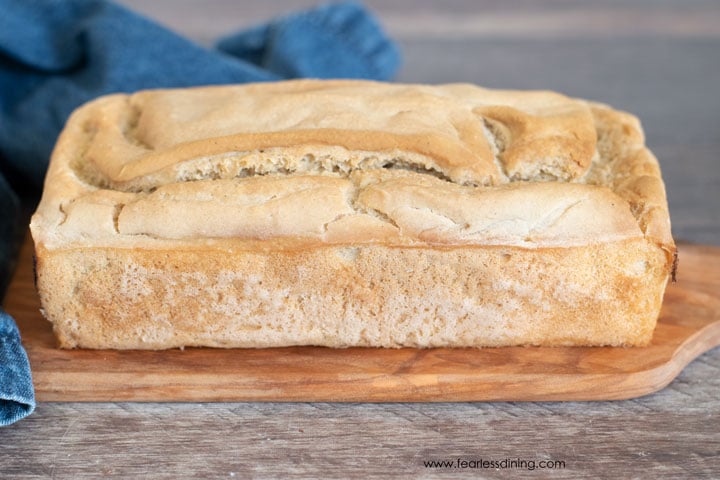
Reader Tips:
I am including many reader tips. There is so much experience in perfecting bread. I encourage you to read the tips and comments section.
It was a pleasure at each step- because it was an adventure. Not everyone is that enthusiastic, I know. But, for someone whom has zero experience in gluten free baking – this brave trial was easy and enjoyable.”
Dana
I am new to gf sourdough bread baking, and each loaf is improving. Only the first was a complete fail due to stickyness. I mix my dough in the a.m., and mid afternoon, I mix a 2 T. boost of flour, ¼ c. of water and 1 tsp of baking soda, add that into the dough and move the dough into my loaf pan for a fairly quick rise. I bake at 400F for an hour after dinner for use the next day. I check temp with a probe for 200+F. I don’t use steam and crust is cruchy/chewy. I’ve used center of oven and low center without noticing a difference. Some tips that may work – fluff flour with fork before measuring, and mix with a fork, too. You can cover your loaf pan with a second for the ride to allow room and protect. Some bake like this to simulate a Dutch oven, but I’ve not tried it yet. If I use the baking soda, it really helps the rise and opens the grain. Otherwise it is fairly sense and short. I am wondering how to reduce stickyness more. I am thinking a different flour may help. I have been using Wal-Mart GF All Purpose and BRM in the red bag. Both have some starches. I usually toast my bread slice and that dried them a bit, too. This has been a fun adventure, and we’ve enjoyed discard pancakes, too.
Chris, reader comment
I successfully babied a sorghum starter for several weeks feeding it regularly and discarding only occasionally until it matured. I have found the process to be not as finicky as it is usually presented and is quite forgiving. I have since made 4 successful loaves of various kinds of gluten free bread, baking once a week and keeping my sourdough in the refrigerator during the week, bringing it out the night before I plan on using it and feeding it. I always make mine with a stand mixer and beat it for 3-4 mins before putting it into a loaf pan forming it with a wet silicone spatula. I always use bottled or spring water in my recipes as chlorine kills bacteria, therefore living sourdough. If I am in a hurry to bake, I add 1 tsp of baking sofa to my loaf. It reacts with the acidic sourdough and causes a faster rise. If I am not, I practise patience…not my finest asset! Sometimes rise may take anywhere from 12-48 hrs for the dough to double in size. Because I live in the great white north, I also always put my bread in the oven with the light on to rise. I oil the top of my loaf lightly with olive oil and place a kitchen towel over it. Once it is fully risen I remove it from the oven and heat my oven to 450. I put the loaf in and then decrease the temperature to 420 for 20 mins. This gives a beautiful chewy crust. Then I decrease my oven again to 375-400F and bake for 30 minutes until the interior loaf measures above 205F. Let it cool completely before slicing up the loaf. Store in the freezer taking out what you will use, defrosting in the microwave until warm. This recipe makes fantastic sandwiches! I use this method with all the loaves I have made and it works great! Hope this helps!
Lois M., reader comment
We’ve accidentally left out the salt a few times at the bakery, and we found that the bread did not rise as much as a salted dough! It was really interesting, and not at all in line with the baking rules I know. The key to getting your recipe down is the balance between water, binder, and bake time. Too little water means the dough can’t stretch enough to take full advantage of the binder. Too little binder, and the water will just make it harder to bake, with less rise because there isn’t enough elasticity. Too low a bake temp means that the amount of oven spring will be small.
Sadie, responding to a reader question about salt
I make mine in a crock pot! I line to crock with oiled parchement and let raise 12-24 hours. Cook on high for 2.5 hours. The top doesn’t brown and isn’t pretty, but it still tastes the same as baking it. Plus it doesn’t heat up my kitchen in the summer!”
Jill H., Pinterest comment
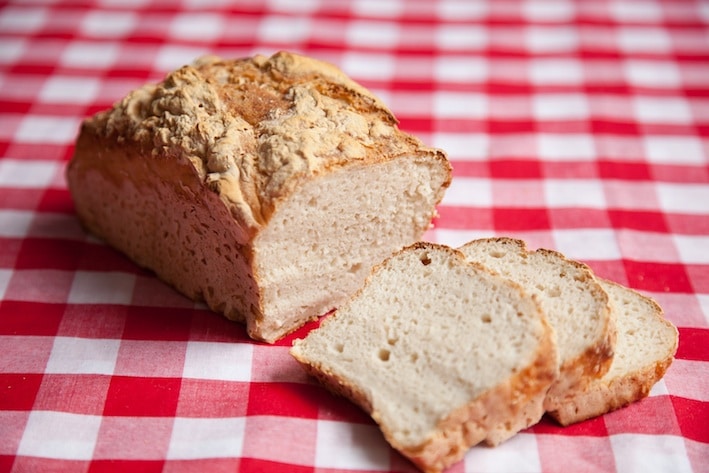
Serve Gluten Free Sourdough Bread With:
If you haven’t eaten a lot of sourdough bread or are looking for some ideas on what to serve it with, here are a few tasty ideas:
- Roasted Chicken – Place pieces of roasted chicken and cheese (if you can tolerate dairy) and toss them under the broiler until it is hot and the cheese is bubbly. Add toppings and enjoy. So good!
- Bread Crumbs – You can dry the loaf of sourdough bread and turn it into bread crumbs. It will go lovely in any recipe that requires bread crumbs, and the flavor is terrific. Try this delicious Gluten Free Meatloaf recipe!
- Dip – Serve pieces of gluten free sourdough with this Hot Cream Cheese Dip, which will go perfectly! It pairs nicely with anything cheese-based too.
If you love gluten free bread, you will want to try these Gluten Free Cheddar Herb Muffins recipes, too. They are so light and fluffy. Also, these Paleo Biscuits are delicious and perfect for anyone who needs to be grain-free!
Sadie’s Original Recipe:
Here is the recipe that Sadie gave me back in 2014, untweaked. Several readers still use this recipe, so I wanted to include this in my article. This is the quote from Sadie, who used a millet, rice, and sorghum flour blend. The salt and xanthan gum are not used in the starter but in the bread:
- Mix equal parts of the flour of your choice and water. Avoid using pure starches like tapioca, corn, or potato starch.
- Leave it in a bowl at room temperature, covered by a towel. Add a little more flour and a little more water every 8-12 hours (2-3 times per day).
- After 3-5 days, the mixture should start to smell sour and have some bubbles. Congratulations, you’re almost there.
- Once your mixture is bubbling, add a little bit to your bread mix. Do not use any yeast. Let this rise for at least 12 hours.
- Once the dough has risen, it will be your sourdough starter! Use a little bit of this dough in a fresh batch of dough.
- You’ll be impressed at how vigorous your sourdough can be.
- Always save a cup or so of your last dough to use as a starter in your next batch.
- Keep it in the fridge, and be sure to “feed” it with fresh water and your blend of flour from the bread recipe at least once a week, but twice if you can.
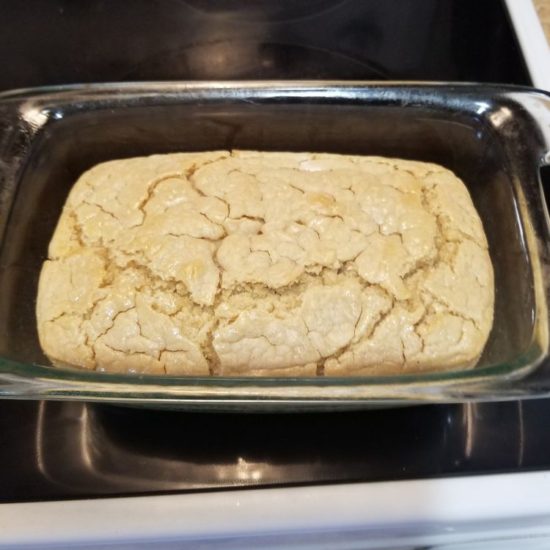
If you want to try another great sourdough recipe, give this Gluten Free Sourdough Bagels recipe a try! If you want to make incredible gluten free bread quicker, try my delicious Gluten Free Bread Machine Bread recipe! If you have discard to use up, try my Gluten Free Sourdough Discard Biscuit recipe!
Love This Recipe?
If you made and enjoyed this recipe, I would be incredibly grateful if you could leave a comment below. Please include which flour blend you used. This will help others know this recipe is delicious. Thank you!
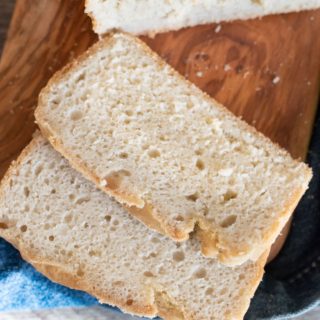
Gluten Free Sourdough Sandwich Bread
Ingredients
- 2 cups gluten free flour blend * see note
- 1 teaspoon kosher salt
- ¾ cup sourdough starter
- 1 cup water by feel You will need more or less depending on the flour blend you use.
Instructions
Do This First:
- PLEASE read the whole recipe post I wrote about making this gluten free sourdough sandwich bread because it is loaded with tips from me and other readers. It is impossible to put them all in this recipe card.
- Go to my How to Make a Gluten Free Sourdough Starter page and make your gluten free starter! Do this first because there is no sourdough bread without an active starter!!
Make The Bread:
- You will need ¾ cup of active gluten free starter. Make sure it is bubbling and at room temperature! If you refrigerate your starter, take it out of the refrigerator the night before you plan to make bread. I take a discard, feed it with gluten-free flour and water, and let it sit on the counter overnight.
- You will want your starter warmer if it is a cold season, especially winter. I like to put my starter either in the oven with the light on or on my Euro Cuisine Yogurt Maker base (with two folded dish towels on it so the starter doesn't get too hot.)
- Put the gluten-free flour and salt into a large non-metal mixing bowl and whisk together. Add the sourdough starter and filtered water.
- Note: It is important to use filtered water. Tap water has a lot of chemicals, including chlorine, which can kill your yeast and decrease the rise.
- Mix the wet and dry ingredients well. You want a wet dough, like a thick pancake batter.
- If your bowl isn't metal, cover it loosely with plastic wrap and let the dough rise for 3 hours (go by how big it rises). It may look lumpy, but that is okay. Let it- don’t overwork- you are eliminating the rise with every stroke. I move the dough to a greased bread loaf pan and let it rise for another 3-4 hours. Cover with a damp towel so the dough doesn't dry out.
- Note that the King Arthur Measure for Measure was a little runnier in consistency. The GF Jules has a much higher starch content and looks much fluffier!
- Bake the gluten free sourdough loaf for 45 minutes at 425º F. I noticed it hadn’t browned on top – so I brushed the top with melted butter at the 45-minute mark and then quickly closed the oven door.
- Bake for another 20-30 minutes and test the bread with a probe-style thermometer. The bread should be between 200-210º F in the center. Note: the bake time will vary depending on the size and depth of the pan you bake your bread in.
- Carefully move the bread to a cooling rack. Cool the bread completely before removing it from the pan and slicing it with a serrated bread knife. You want the bread to cool for a minimum of 3-4 hours before slicing it.
Notes
- Read the entire post. You will miss a lot of tips and tricks in making this recipe a huge success.
- I have tested this recipe with King Arthur Measure for Measure and GF Jules blends. Readers have tested this recipe with Nameste, Krusteaz, and Bob’s Red Mill 1:1.
- Note this is a recipe that came from Sadie at Bread Srsly. She has many tips in the article and 100s of reader comments filled with tips.
- Store the bread in an airtight container. I always recommend slicing and freezing the bread slices if you are not going to eat the loaf quickly. Freeze when the bread is fully cooled in a freezer-safe zipper bag.
How to get crusty bread:
I highly recommend baking this bread with a pan of hot water on the lower rack in the oven to create steam. (Sadie at Bread Srsly didn’t do this, but I found baking with hot steam creates a really good crust to the bread.) To get steam, you can fill a shallow baking dish with very hot water and put it on the bottom rack in your oven when you turn the oven on. Keep it there the first 30 minutes that your bread bakes.SPECIAL NOTE
Please know that every gluten free flour blend has a different starch to grain ratio. If you use a blend I didn’t test, you may need to adjust your moisture levels in your baked goods.
Nutrition
Nutrition Disclaimer
Nutritional information is an estimate provided to you as a courtesy. You should calculate the actual nutritional information with the products and brands you are using with your preferred nutritional calculator.

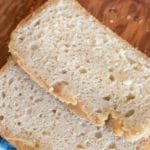
Hi, I’ve tried making it with Bob’s Red Mill 1 to 1 GF flour. The taste is great but it’s very sticky. I read that this is because rice flours absorb a lot of water and BRM uses a lot of it. I’m thinking of coming up with my own blend of flours. Do you have a combination that you can recommend?
Hi Joy, I would read through comments and see what others use. I have made this with King Arthur Measure for Measure and GF Jules flours. I bought Namaste and plan to try that flour blend out soon. If it was sticky, did you check the internal temperature? Also, did you let it cool completely before slicing? How long did it rise in the loaf pan?
Hi Sandi,
I let it rise for 24 hours. Internal temperature was 210. I let baked loaf dry in the fridge for 24 hours and it wasn’t as sticky when I sliced it the next day. I’m going to experiment with sorghum flour next.
I love your updates Joy, I am glad it wasn’t as sticky!
Hi! This sounds like a great recipe. Can I use Namaste gluten free perfect flour blend for this sourdough bread recipe? I have a brown rice gluten free starter. If this will work how much water would you recommend I try? Do you have any other tips…. I am very new at gluten free sourdough. Thank you.
Hi Karen, I haven’t used this flour blend, though I did buy it recently to experiment with. Is your starter all bubbly and ready to use?
Hi Sandi,
Yes it is. I had another question. Would it be possible to use parchment paper instead of greasing the pan? Thanks!
Hi Karen, parchment paper should be fine. Thank you for asking.
I’ve just pulled my second loaf out of the oven after nearly 2 HOURS (@375) and it’s still not cooked through. I’m not sure what’s going wrong. Perhaps it’s this Bob’s Red mill 1 to 1 flour. I know one person had luck with it, but I wonder how many others have. The starter is beautiful, then I mix with the ingredients listed above, this time using 2 1/2 cups of water. The “dough”/batter rose HUGE overnight. Do you mix after this rise before pouring into the loaf pan for a second rise? Mix and add flour/water? I didn’t mix or mix anything in. I got a slight second rise in the pan and put it in the oven thinking it would rise more while baking, but instead it collapsed! and now…. it’s not baking 🙁
any tips?! I’m thinking the next loaf should be baked at 400, but I’m at a loss as to where else to go. Any other help would be greatly appreciated! Thank you 🙂
Several readers have used this flour blend, as I have also seen some use it in the FB group GF Sourdough. How runny was your batter after the big overnight rise? Please walk me through your steps including water to flour ratio each day, temperature where you let it rise, how you covered each day, etc. The more details you give me the easier it will be for me to help troubleshoot this. Thank you.
Oh my goodness, thank you for helping! I didn’t weigh my ingredients, but measured 2 cups flour, 2 1/2 cups water and 1/2 cup of a very bubbly starter, along with the 1.5t salt and 1t sugar. After the big overnight rise (covered with a damp cotton tea towel in the oven) it was pretty runny… a little runnier than cake batter and had a lot of air bubbles. I didn’t stir it or add any more flour/water… I just poured it into the loaf pan and let it sit/rise for about 3 hours. It had risen a bit more and I put it in the preheated 375 oven for an hour. It rose a bit then collapsed around the 30 min mark. I added melted butter and checked temp at the hour mark and the probe came out covered in sticky residue (like oatmeal). Temp was 190. I left it in until the temp was over 200 and took it out. The consistency of the inside was just like cooked oatmeal, it just didn’t cook at all. it was really weird. I have a few pics of the final product if you’re interested. Thank you so much for taking the time to troubleshoot with me!
You are very welcome. That water content sounds pretty high. Next time I would cut back on the water content. Please email the pictures at sandi@fearlessdining.com
My loaf rose beautifully but than sank when baking. I’m wondering if I added too much water but the consistency seemed good. Can you please suggest a range of water to use?
Hi Cathie, which gluten free flour did you use and what temperature was your oven? I will try to write out the amount of water I use, but it varies by gluten free flour and blend ingredients because some absorb water more than others.
Thank you Sandi. I used Bobs 1-1 and the temp was 375.
Hi! This happened to me with my bake yesterday. My pervious bake was better and by bread rose nicely in the oven. I also think the culprit was too much water. I’m a novice and din’t record the amount of water I used on my first bake… or second bake for that matter. ha!
Have you noticed that you need a longer bake time as well? I would love to hear what happens after your next bake.
Hello. I tried fermenting this dough in my pan for 24 hours and noticed that the top got pretty dry and hard. I stuck it in the oven as is and after it baked, the top had this really hard crust that was whiter than the rest of the loaf. Is there a way to prevent this from happening?
Hi Joy, I am a little confused and need some clarification. What flour blend did you use, how wet was the dough, and did you cover the pan? This info can help me troubleshoot with you.
Hi Sandi,
I used Bob’s Red Mill 1to1 GF flour. I made sure the dough was as thick as pancake batter just like the recipe said.I did not cover the pan with a wet towel and just left it out in the kitchen counter overnight.
Next time please do cover it, this help keep the starter from drying out. It also prevents dust and other things from falling into your starter.
I’ll try covering it next time. I will let it ferment for 24 hours. It’s really hot where I live. if the towel dries out, do I re-wet it?
I would make sure your batter is a little wetter when you put it into the loaf tin to compensate for the loss due to hot weather.
Hi Sandi,
I used Bob’s Red Mill 1 to 1 GF flour. I made sure the dough was the consistency of pancake batter just like the recipe said. I didn’t use a wet cloth to cover my pan. Instead, I used a cheese cloth. The flavor of the bread was great. It had a lot of air bubbles and I’m happy with the consistency. It’s really just the top that I need to fix. Is there a way I can post a photo so you can analyze it?
Hi Joy, please email me a photo to sandi@fearlessdining.com I am happy to help. Half way through baking I like to spread melted butter on the loaf to get it to crisp and brown.
Thanks for all your help. I sent you the photo.
Hi Sadie
I’m experimenting with Sadie’s wonderful recipe and would like to substitute the xantham gum with psyllium husk powder. How much psyllium husk powder should I use if the recipe calls for 2 tsp of xantham gum?
Thank you so much.
RB
Hi Ravinder, I haven’t personally used psyllium husk so I am not fully sure. I would try 1-2 teaspoons and see how it goes.
Do you have a copy of Sadie’s recipe that I can play with too? I just made my first starter…:)
Hi Sandra, the recipe is the same, except she used a combination of millet and rice flours. The instructions in the recipe card are identical to hers. This is the quote from Sadie
“Mix together equal parts a flour of your choice and water. Avoid using pure starches like tapioca, corn or potato starch. Leave it in a bowl at room temperature, covered by a towel. Every 8-12 hours (2-3 times per day) add a little more flour and a little more water. After 3-5 days the mixture should start to smell sour and have some bubbles. Congratulations, you’re almost there. Once your mixture is bubbling, add a little bit in to your bread mix. Do not use any yeast. Let this rise for at least 12 hours. Once the dough has risen, it will be your sourdough starter! Use a little bit of this dough in a fresh batch of dough. You’ll be impressed at how vigorous your sourdough can be. Always save a cup or so of your last dough to use as a starter in your next batch. Keep it in the fridge, and be sure to “feed” it with fresh water and your blend of flour from the bread recipe at least once a week, but twice if you can.”
Ravinder,
You might like to check out mygluten-freetable.com for amount comparisons and an explanation of the differences between xanthan gum and psyllium husk powder. I’ve used both, and used them in combination (excellent thin crust pizza result). Psyllium may give an encouraging rise, but it always disappoints because breaks down during baking. The result can be gummy and dense.
LOVE this recipe
I made it once then immediately made another to bake the next day
My first try was kind of a mess…so for flour here are my alterations
Ok so the first one was the millet water (so i added it first since i knew to add water by feel) and it was only a little
But then i also did 1/2 cup cassava and 1/2 cup bobs red mill gf mix (the red label that is a mix of fava and chickpea and sorghum) and then 1 cup of ground hulled millet (the hulled is much cheaper for some reason so i run it in the vitamix dry cup) and that included the water/millet mix overflow for the feeding
The second batch (currently in the oven) was 1 cup of hulled millet and 1 cup of the bobs red mill gf mix
Thank you so so much for coming to say how you made this recipe so delicious! This recipe is a work of many, and as people try new things I love to add it to the post so others can learn from all of our experimentation.
I’ve been baking this bread almost weekly for years. (My sourdough starter is my happy little third baby!) It’s spoiled me rotten for any other gf bread. Has anyone ever tried letting it rise in the bread pan you plan to bake in? I’m so interested to see if I’ll get the massive rise Bread Srsly has when I order loaves from them, but chicken to have it overflow the pan and ruin my bread—and oven!
I am so glad you love this recipe Becky!! Hoping someone will have an answer for you 🙂
After reading everything I could get my hands on regarding the gluten free sourdough I decided to give it a go after 8 yrs of celiac disease. I successfully babied a sorghum starter for several weeks feeding it regularly and discarding only occasionally until it matured. I have found the process to be not as finicky as it is usually presented and is quite forgiving. I have since made 4 successful loaves of various kinds of gluten free bread, baking once a week and keeping my sourdough in the refrigerator during the week, bringing it out the night before I plan on using it and feeding it. I always make mine with a stand mixer and beat it for 3-4 mins before putting it into a loaf pan forming it with a wet silicone spatula. I always use bottled or spring water in my recipes as chlorine kills bacteria, therefore living sourdough. If I am in a hurry to bake, I add 1 tsp of baking sofa to my loaf. It reacts with the acidic sourdough and causes a faster rise. If I am not, I practise patience…not my finest asset! Sometimes rise may take anywhere from 12-48 hrs for the dough to double in size. Because I live in the great white north, I also always put my bread in the oven with the light on to rise. I oil the top of my loaf lightly with olive oil and place a kitchen towel over it. Once it is fully risen I remove it from the oven and heat my oven to 450. I put the loaf in and then decrease the temperature to 420 for 20 mins. This gives a beautiful chewy crust. Then I decrease my oven again to 375-400F and bake for 30minutes until the interior loaf measures above 205F. Let it cool completely before slicing up the loaf. Store in the freezer taking out what you will use, defrosting in the microwave until warm. This recipe makes fantastic sandwiches! I use this method with all the loaves I have made and it works great! Hope this helps!
Wow Lois, you are amazing… I love the extra tips and tricks you wrote up, I am sure they will help others make this bread.
Hi! Hoping for some advice. I started my starter 5 days ago. it’s growing and smells like sour dough, but it’s not really “ bubbling”. Is it ready or should I wait?
R
Hi Traci, are you consistently adding a little flour and water every 8 hours or so (3x a day?) If there is slight bubbling I would wait another day or two and see.
Thank you!
You are welcome 🙂
I am trying this, as I read through this recipe several times and it was a little confusing as to do I let it rise 12-24 hours in a bowl and then let it rise another 2-12 hours in the bread pan. In all of the confusion I transferred it from a bowl after 4 hours, thinking I had done it wrong, into a loaf pan. I’m not moving it again. So we’ll see how it goes in the loaf pan.
I wish this recipe was a little clearer on the steps. I’m reading it on my mobile…as I’m sure a lot of people do, and it’s just a lot of scrolling back and forth trying to make sure I got the steps straight. And it’s really a simple recipe. 🤣🤣🤣
I hope it turns out.
I tried another one, kind of similar the other day and it never would rise.
I’m using a King Arthur gf flour and starter and my starter is really nice and bubbly. So hopefully it works. 😬😬😬
Hi Erin, you should be fine not moving it. It is a beast of a post, I try to include tips from readers, info on different flours etc. I just separated out the entire section on the starter to a new post trying to slim it down. I will try to work on it some more. I do have a table of contents to try to break it up easier for phone as well.
Hey thanks so much!! 🤪🤪
I have mine in the loaf pan in the oven proofing and I added Parmesan cheese in the dough and it smells heavenly!! I’m excited to see how much it’s risen in the morning!! I cannot wait to actually bake it!!
I may put another loaf together tomorrow since it has to rise so long. I’ve got starter coming out the wazzoo. 🤣🤣🤣🤣🤣🤣🤣
LOL, I have a ton of starter too. What else do you like to make with it?
I’m late to the party here but hope someone can provide some insight. I put my “pancake batter” into a 9X5 glass loaf pan. It is currently rising in a lit oven. I am trying to decide if I can just bake Elias risen or…do I have to transfer to another loaf pan before baking. Transferring and potentially losing some leavening seems like an unnecessary step. Can it just be baked?
I haven’t tested your idea to just bake it at that stage so I am unsure how to advise you on your questions. If you do try it, please come back and let us know if it worked.
i have this rising today as i made it last night. It seems like a sticky kind of play dough. I added more water last night but it was just like a muddy sludge. Hoping it rises today and bakes well!
Please do keep me posted. A recent commenter listed her step by step process for making this bread, it is worth looking at what she says about the dough.
Hey People! If you have used arrowroot flour in your bread and allowed the batter to then rise, then Stuckey or even gooey is your fate; you can bake it forever and it will be like crusty sludge. Arrowroot is so hydrophilic that it is a water magnet and almost impossible to dry out. If baking with arrowroot you need to mix and bake IMMEDIATELY to have good results, so it is more suited to cakes and muffins, in combination with, say, coconut flour or brown rice and buckwheat. Good luck.
When making this bread it is alive. Regular tap water with chlorine if used will kill the good bacteria / yeast resulting in no rise / use distilled water when working with live foods
It would be great if you could give an internal temperature for the bread when it is ‘done.’ I baked mine for an hour, and discovered it really wasn’t cooked all the way through. So having an internal temp to check would be great. Thanks.
Hi Laurel, this is a guest post by Sadie, so I am not sure what an internal temperature she would recommend. Sadie checks in on this post and I am hoping she can answer this question for you.
Minimum is 205 degrees internal temperature. Often 210 is better.
Thank you Lisa!!
Hi there,
INTRO:
I’m not Celiac but quite sensitive to Gluten and Wheat especially, with bloating and severe water gain and swelling. Still being very new at Gluten Free home baking, I chose to attempt this recipe using Bob’s Red Mill One to One GF Baking Flour(R). Silly me, didn’t read the fine print of the ingredients, so I found later that there is some Tapioca and Potato starch in the product. Well- the worst that could happen is the starter wouldn’t rise and behave correctly. A whole bag of flour wouldn’t be wasted, just the bit that I used for starter.
STARTER for a new GF Baker:
I chose to begin the Starter with 1/4 C of 1 to 1 Bob’s with 1/4 C of Water in a mason jar. I left the lid ajar for air. I did notice that this didn’t work as well as a loose cotton dish towel over the jar, instead of the lid. Once using the towel instead of the lid, I believe ambient yeast collected more easily and I began to “get a rise” out of the starter. Sorry for being so detailed, but being new at GF baking, I’m attempting to offer as much info in my steps – to help someone else troubleshoot their baking experience of this recipe.
MIXING up my First Batch
Instead of going exactly by the recipe – I continued to use Bob’s Red Mill 1 to 1 in exchange for all the flours listed. All of those flours and the arrowroot is included in the 1 to 1 Baking flour – thus the reason for this choice. Also- I was attempting to find the most economical way of baking this bread. Measurements I kept the same – so instead of 1/2 C of each flour plus the arrowroot powder – I used 2 cups of the 1 to 1 baking flour, the Salt (Pink Himalayan Sea Salt) the Xanthene Gum and the water until I had a decent consistency of a medium thick Pancake batter. I used the Kitchenaid metal mixing bowl and covered loosely with the cotton kitchen towel for a full 24 hours. I did this because at 12 hours- it hadn’t seem to rise to it’s full potential.. At about 18 hours, there was a full-doubling rise, so kept it going for any best rise possible.
BAKING my First Loaf:
I didn’t have shortening to grease with – but I did have cruelty-free obtained coconut/palm oils-so I used that on a new non-stick metal 1 lb. loaf pan and coated well using a basting brush. Don’t overwork the “batter”. Fold it in the greased pan and let it settle on it’s own while preheating the oven. It will look lumpy. Let it- don’t overwork- for every stroke- you are eliminating the Rise. The flour mixture that I used had White and Brown rice flour and so more water was used to get that Pancake consistency before baking. I baked at 375* F(also measured with baking thermometer) on middle rack of the oven. I baked for 50 minutes, then turned on the oven light to closely monitor for the last minutes of baking. Also at this time, I noticed it hadn’t browned on top – so I brushed the top with my coconut/palm oil mixture for the last 10 minutes, hoping it would brown up a bit. I’m sure butter would work beautifully as well. Hurry when gently brushing it on- the longer the oven is open and rack pulled out a bit – will lose a tiny bit of it’s Rise. Once oven is closed again, the Rise came quickly back. Baked for the full 60 minutes and then with a Probe style Roasting Thermometer showing 160-180*F in the center. I did notice that it had a bit of residue on the probe- so I turned off the oven and left the loaf in to cool that way, hoping to finish baking and cooling more gently to keep as much of the final Baked in Rise and fluff. Cooled completely before removing from pan and slicing with a serrated bread knife.
CONCLUSION:
I’ve tried a lot of GF breads – the online, the super pricey, down to the cheap or clearanced (aka cardboard tasting). As an Artisan sourdough bread fan – I have to say the experience of starter, mixing, baking and finally eating it – the trouble I went to was well worth it. It was a pleasure at each step- because it was an adventure. Not everyone is that enthusiastic, I know. But, for someone whom has Zero experience in GF Baking – this brave trial was easy and enjoyable.
TASTING: WOW! Quite authentic Sourdough Bread flavor. Doesn’t toast up Brown as easily as it’s Gluten filled relative, but I’m very pleased with the results, the RISE, and flavor. I can finally have Sandwiches again after 3 years of going without buns, rolls and deserts because wheat and gluten were giving my stomach and body such fits.
I know this was long winded – I hope it helps and encourages others to try as well.
Good luck and enjoy!!
Dana
Wow! Dana you are so wonderful to come and comment with such full directions to help other readers. Thank you so much!! I am hopeful that your encouragement will help people who are newer to gluten free baking to try this recipe.
Hi
Are you able to put up a conversion to grams please? I have all sorts of trouble trying to figure out if you firmly pack the cup measurements or if you are using metric cup measurements or something else. (new to sourdough baking?
Thank you.
Hi Raylene, Unfortunately, this isn’t my recipe it is Sadie’s and I am not familiar enough with grams to reliably convert this recipe. You may consider finding an online converter.
I’m sorry, I am confused. How is this yeast free? A wild starter is yeast, its just ambient yeast that is collected from the air rather than a commercial, packaged yeast, but its still yeast.
Hi Alison, I can try to ask Sadie for you since this is her recipe.
I tried twice to make this bread and it came out great except it did not rise much . We have toasted it and it is truly a winner, however I would love to find out why it did not rise as much ? maybe more water ? does it really have to have the consistency of pancake batter before I let it rise ? that’s pretty wet, right ???
My first thought is to try more water. Sadie gave this recipe, and she wanted people to use it as a base to experiment from. Please let us know if more water helps.